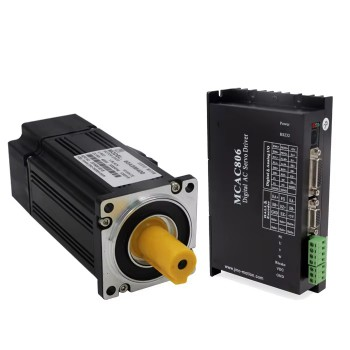1. Basic definition of servo motors
A servo motor is an actuator motor used to precisely control the movement of mechanical components in a servo system. It can convert electrical signals into angular displacement or angular velocity, and has the characteristics of high precision, fast response and high stability. It achieves precise adjustment of position, speed and torque through a closed-loop control system, and is widely used in automation equipment, robots, CNC machine tools and other fields.
2. Working steps of servo motors
1. Control signal reception: The controller (such as PLC, motion controller or microprocessor) generates a control signal according to a preset control algorithm, representing the desired motor position, speed or torque.
2. Precision control: After receiving the control signal, the servo drive adjusts the power supply to the motor to ensure that the actual motion state of the motor is consistent with the requirements of the control signal, involving complex current, voltage regulation and pulse width modulation (PWM) technology.
3. Feedback mechanism: The built-in or external encoder monitors the actual position, speed and/or torque of the motor in real time, and feeds this information back to the drive and even the controller.
4. Closed-loop control: The driver compares the actual feedback value with the target value of the control signal, calculates the deviation and adjusts the motor's drive current accordingly to achieve closed-loop control, ensuring that the servo motor can respond to the control command quickly and accurately, and achieve high-precision positioning and dynamic performance.
3. Main control methods of servo motors
1. Amplitude control : By changing the amplitude of the control voltage, keeping the frequency and phase unchanged, the speed and torque of the motor are adjusted. In essence, the output is controlled by adjusting the voltage amplitude to affect the magnetic field strength.
2. Phase control : Keep the control voltage amplitude and frequency unchanged, only change the phase difference, and affect the rotation direction of the magnetic field or the size of the synthetic magnetic field through phase changes, thereby adjusting the motor's operating state.
3. Amplitude-phase control : Simultaneously adjust the amplitude and phase of the control voltage, comprehensively adjust the magnetic field characteristics, and achieve precise control of the motor.
4. Speed control , position control and torque control : These are the three most common control methods for servo motors. Speed control is used to adjust the speed of the motor; position control is used to accurately control the position of the motor; torque control is used to adjust the output torque of the motor.
5. Fuzzy control: The motor parameters are self-learned through fuzzy logic algorithms to improve the stability and response accuracy of the motor under different loads and operating conditions. This method obtains the correlation information between the motor structure and load changes by jointly sampling and eliminating interference from multi-source operating data in the industrial site.
6. PID control: In complex environments, the three-loop superposition PID control logic of the current loop, speed loop and position loop is used to optimize the pointing stability and communication performance of the motor. This method can effectively overcome the limitations of the single-loop PID control of stepper motors and ensure the stable pointing and communication performance of the motor in various complex environments.
4. Servo motor maintenance tips
1. Regular inspection and maintenance: Regularly check the various components of the servo motor, including encoders, bearings, gears, etc., to ensure that they are firmly connected and well lubricated. Clean the dust and dirt on the surface of the motor to keep the motor clean.
2. Avoid overload operation: Match the rated load and speed of the motor reasonably to avoid overload operation. Check the maximum radial load force of the motor, improve the mechanical design, and ensure that the motor runs under a reasonable load.
3. Pay attention to heat dissipation issues: Ensure that there is enough ventilation space around the motor to avoid overheating of the motor. Clean the air duct and take cooling measures to ensure that the motor runs at a suitable temperature.
4. Reasonably control the operating environment: Ensure that the temperature, humidity, dust and other factors of the motor operating environment are within a reasonable range. In high temperature, high humidity or dusty environments, the heat dissipation and cleaning of the motor should be strengthened.
5. Check the connection wire regularly: Check whether the motor connection wire is loose or damaged to ensure a firm connection. Check whether the motor grounding wire is reliably grounded to ensure the safe operation of the motor.
6. Check the lubrication condition regularly: Regularly check the lubrication condition of the bearings and gears of the servo motor, and add or replace the lubricating oil in time to ensure the smooth operation of the motor.
7. Follow the operating procedures: When operating the servo motor, the operating procedures and safety specifications of the equipment should be followed to avoid improper operations such as frequent starting, stopping or overspeeding to reduce impact and wear on the motor.
Source:https://plaza.rakuten.co.jp/yixing/diary/202506040000/



